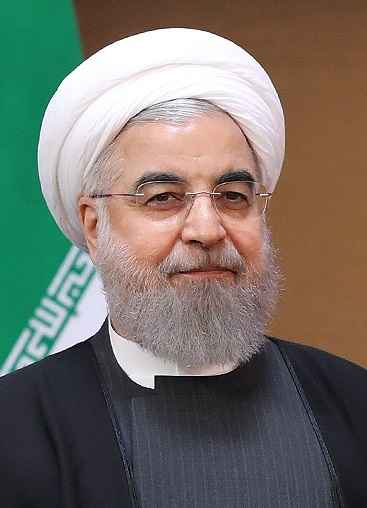
According to news reports, it began in Mashhad on December 28, 2017 as a preplanned celebration of the anniversary of the crackdown on the 2009 Green Movement. In Iran’s second largest city with some 3.3 million people, the hardliners won the 2016 election. In the organized gathering, they wanted to voice their protest against President Rouhani and his reforms.
Indeed, even the first vice-president of Iran — there are 12 vice-presidents in total —, Eshaq Jahangiri, said that the first protests in Mashhad had been organized by hardliners in order to weaken President Rouhani’s reforms. He warned that they could get out of control.
And he was right. In Mashhad and later elsewhere, including the capital Teheran, the anti-Rouhani protests quickly turned into anti-regime protests. The rising inflation and unemployment rate, the level of corruption, Iran’s military and foreign policy expenditures, notably in Syria and Lebanon, were targeted by demonstrators. The moderate President Rouhani as well as the ultra-conservative Supreme Leader Khamenei were criticized. Some chanted “death to the dictator”. The Revolutionary Guard was vocally targeted. The mostly young and male demonstrators even openly demanded the overthrow of the totally corrupt, clerical regime.
By December 31, at least two people have reportedly been killed and some 80 protesters have been arrested. In addition, the regime slowed down the internet and blocked social networks.
Since the 2015 nuclear deal between Iran and the permanent members of the United Nations Security Council (USA, UK, Russia, France and China) as well as Germany and the EU (known as P5+1), the economic situation in Iran has not improved for the average Iranian. People are disappointed. A BBC Persian investigation concluded that on average Iranians have become 15% poorer over the past decade. Especially young people in Iran run out of patience with the regime. At the same time, the regime can claim some successes.
According to Gil Yaron in the German newspaper Die Welt, Iran’s oil production increased 60% in 2017 in comparison with the pervious year, tax revenues are 80% higher, for the past two years, inflation has been curbed to single digits. At the same time, subsidies for water, electricity and oil have been massively cut. In 2007, those subsidies accounted for 27% of GDP. By 2016, that number had fallen to 3.4% of GDP. In 2016, GDP rose by 12%, in 2017 by 5%. However, only the rich and corrupt are profiting from it. Officially, the unemployment rate stands at 12%, unofficially at 25%. Some 40% of Iranians are poor. According to estimations by the Iranian opposition, some 2 or even up to 7 million Iranian children don’t go to school but have to work instead. 70% of Iranians don’t eat enough protein, 80% not enough fruit and vegetables. The 2018 Iranian budget includes a rise of the oil price by 50% and the elimination of social welfare for 34 million Iranians. No wonder many Iranians consider the regime and not the U.S. or the sanctions as the main problem, Gil Yaron concludes.
Unfortunately, the Iranian protests have little chance of success… unless they become a mass movement. The theocratic regime has the monopoly of power. There is no organized opposition, even less so a potentially armed one. At any time, the religious regime could brutally crack down on the opposition. So far, the people on the streets are far from the numbers seen in the 2009 Green Movement protests. Nevertheless, the 2017 demonstrations are the largest anti-regime manifestation since the Green Movement.
Because the 2017 protests target both the moderate Rouhani and his government as well as the hardliners, including the conservative Supreme Leader Ali Khamenei (*1939), a crackdown is more than likely if the entire Islamist regime is at risk.
As for President Trump’s vocal support, as right as it may be in substance, it is counterproductive. The corrupt, religious Iranian regime will paint protesters as U.S. agents or at least as disloyal Iranians who play into the hands of the U.S.
Nevertheless, through diplomatic and other, lower level channels and backchannels, the United States and the West as a whole must make it clear to the Iranian regime that a brutal, bloody crackdown on peaceful protesters would have consequences, e.g. economic and other sanctions.
As stated in 2016, Iran is not Cuba. The Islamic Republic is aggressively pursuing shady foreign and military policy goals in Syria, Lebanon, Yemen, Iraq and elsewhere. Even without the 2017 Iranian protests, the Islamic Republic should not be treated with gloves.
The real opposition in Iran has been silenced, imprisoned and/or exiled a long time ago. There is no oppositional leader with a substantial following. With the opposition divided and weak, change can only come from within the regime or through a mass movement that even a ruthless, bloody regime, which has executed way over 120,000 people since rising to power in 1979, would not be able to suppress.
Persian sheet music. Beauty items at Amazon.com, Amazon.co.uk.

President Hassan Rouhani at the Sixth International Conference in Support of the Palestinian Intifada in Tehran on February 21, 2017. Photo from the Ali Khamenei website / Wikimedia.
Article added on January 1, 2018 at 00:01 Lithuanian time